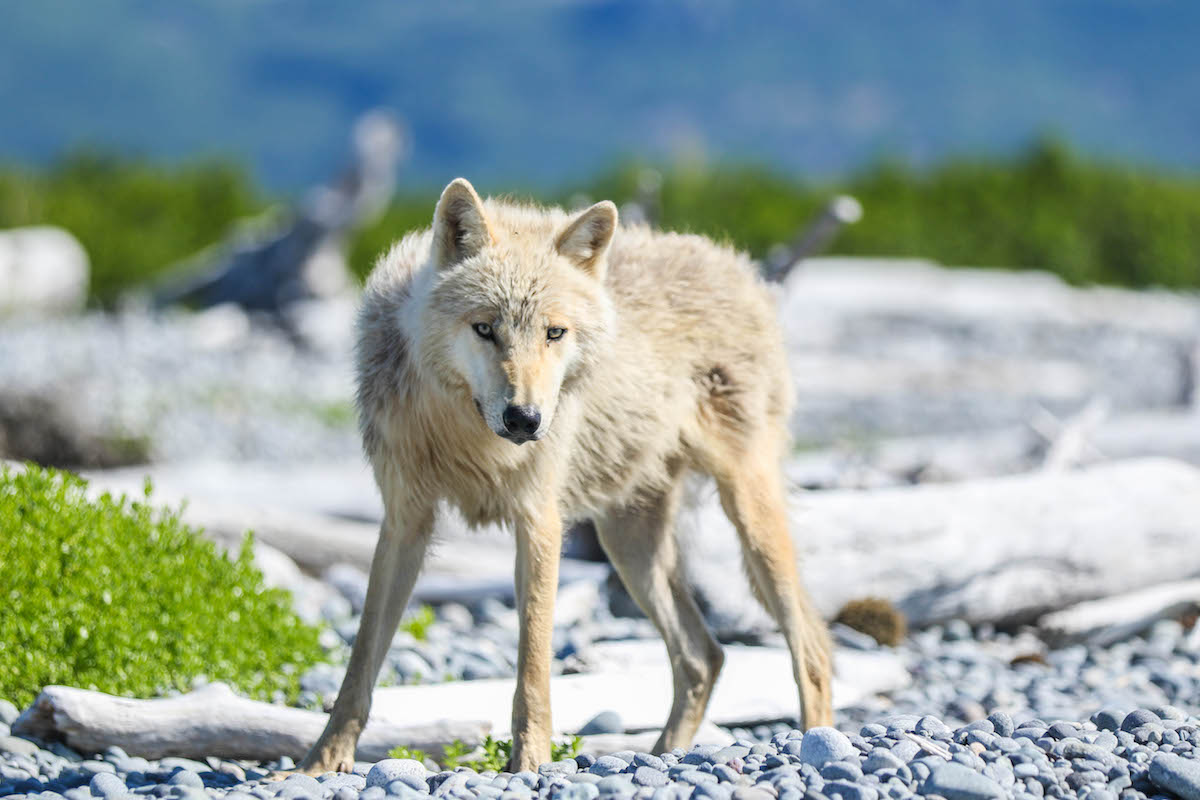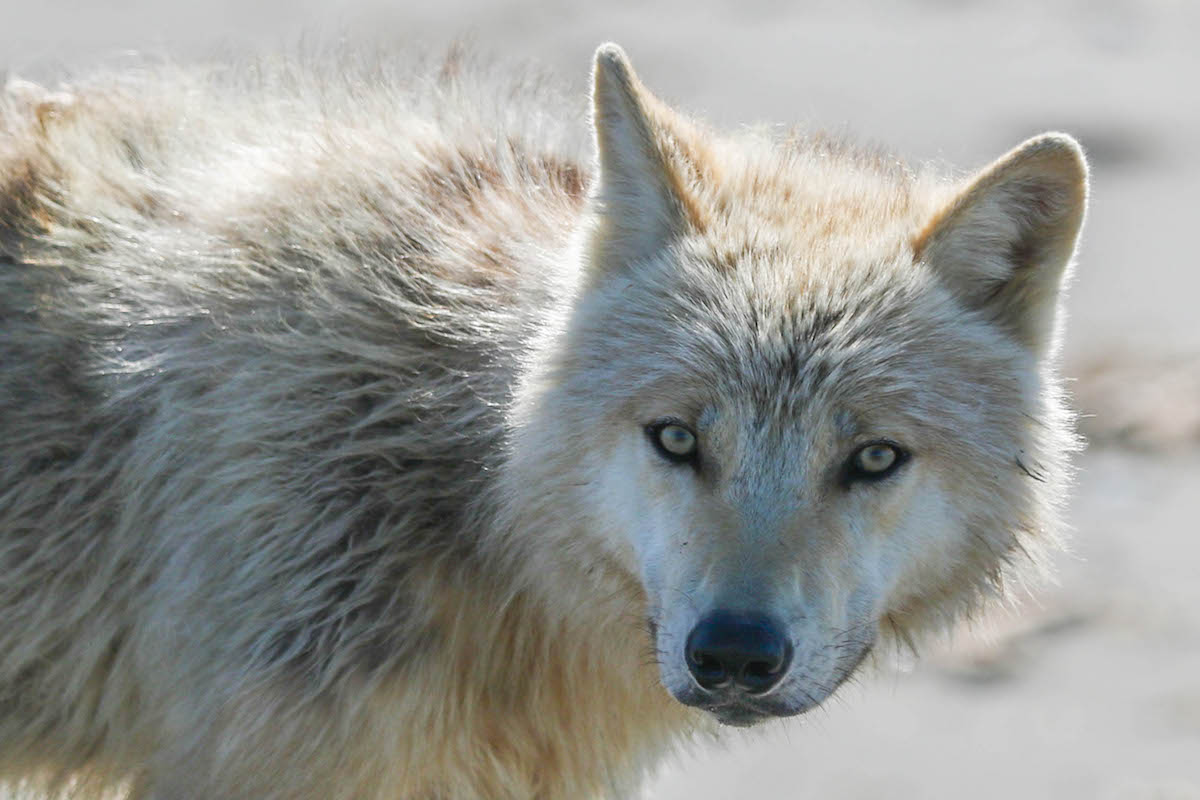Some moments deserve extra attention to detail, because even amidst experiences one could describe as “special,” something astonishing happens.
I stood within a few yards of a wild wolf on Katmai’s coast. He had approached us, in broad daylight, on a sunny beach. If I close my eyes, I can still see him clearly. It is a peak memory of the summer, something only possible because of the protections that keep Katmai such a vivid and wild place.
We were waiting on the beach with our gear for our ride: a tiny bush plane that can land on sand. For the past week, we had been a part of the Changing Tides Project, participating in efforts to check on the health of bears on the coast. I was with Isaac Kelsey, a coastal technician, and Monica Bradburn, a photographer. While we were there, signs of wolves were everywhere, more evident than anywhere I have ever travelled. Tracks danced across each beach. When our floatplane slid into Swikshak Lagoon days earlier, there was a she-wolf moving on the shore. She watched us curiously as we carried gear into camp.
Later, we heard them. On a sunny afternoon, a chorus of howls rang in the distance. It carried on for minutes: deep calls and short yips weaving together in song. Everyone in camp was silenced. There is something in a wolf’s call that strikes to the core, cuts to an almost primeval awareness. What could they be communicating? Were they sending a signal to another pack? Were they ramping up for a hunt? Was it a cry for the pure joy of it? Pages of text have been spilt over this music, but when you hear it in the wild, it still inspires a jolt of wonder.
Later, while we were examining tide pools along the coast for everything from sea stars to hermit crabs, we came across a half eaten sea otter. Keen hunters, the wolves of the coast thrive on its abundance, feeding on seals, otters, salmon, crab, and flounder. This otter was possibly cached for later meals. Isaac collected the skull, (a morbid task, he notes, but important for current research), preparing to send it out to researchers who have been monitoring the health of otter populations on the coast. Scientists are keen to document the sources of otter mortality. The otter population in the park is strong today, successfully recovering from historic overhunting, but it is still vulnerable to changing conditions.
It was likely that otter skull that led to our most dramatic wolf encounter. While waiting for our plane, we glimpsed a wolf foraging along the shoreline about a mile upwind of us. “I hope that one comes our way,” Monica said, her camera ready. Each of us was delighted when we saw him approach closer, closer then we dared hope.
Then he came closer still.

NPS Photo/M. Bradburn: Coastal wolves are often solitary hunters when not seeking prey like moose. Each member of the pack works independently to gather food for the whole group.
His eyes were a striking yellow, watchful and intelligent. His coat was fine and bright. He was a picture of health, and he moved with confidence. When he approached us closer, it became clear that he was more than just curious. His keen sense of smell could detect meat at a distance even when it was triple bagged.
Wolves are a symbol of fear in much of western culture, viewed as a threat for as long as people have herded livestock. Yet I knew this wolf was not particularly interested in us. The otter skull near our feet, however, was a powerful motivator. Circling around us, his eyes scanning every detail, he searched for an opening. Were we less guarded, it is likely he would have made off with a prize. But we understood the meaning of his motions, and were ready to react.
Ordinarily, we would move away, keeping a distance of 50 yards to ensure wildlife remained wild. In this case, we had food to guard, and so we worked to ensure that the wolf would not become food habituated. We spoke to him firmly. Still he moved a little bit closer, his head turning to regard each of us in turn. We sounded an air horn. He flinched but was undeterred, calling for a new strategy. Striking a flare, Isaac held the burning signal to the side and took a few warning steps. This had a greater impact. The wolf, alarmed by the sound and the fire, moved past the lines of driftwood, closer to the vegetation. Isaac tossed a couple of rocks nearby, careful not to hit the wolf. With these final surprises, the wolf decided the risk outweighed the reward, and moved into the alder that lay beyond.

NPS Photo/ M. Bradburn: Park staff use flares in rare circumstances as a deterrent in wildlife interactions on the coast. The high winds often render bear spray (also seen here) unusable.
I felt a lingering wonder mixed with a hint of sorrow. I ached to see more of him. Anyone who has ever been moved by a close encounter with a wild animal can possibly relate. When he held me in his gaze, I was awestruck by him. His every movement, every behavior, was fascinating to witness. I have been close to wolves in a wildlife sanctuary. I had never seen one in the wild. I do not know if I will ever have such a close encounter again.
The rarity of this event becomes more and more evident as we talk about what just happened.
“People pay up to thousands of dollars to see wild wolves,” Isaac reflects, “In the majority of wild sightings, they are hundreds of yards away. Most people don’t see any, or they see coyotes and mistake them for wolves. This one walked right up to us in broad daylight. That just doesn’t happen!”
So why would a wolf approach us in the middle of the day here? The more interesting question might be why it doesn’t happen more often. Wolves once spread across the majority of North America. They were extirpated through heavy hunting in most of the country, and remain heavily hunted in much of what is left. Only in a few places is the level of protection so high that they can only be shot with cameras. Outside of large wilderness areas and National Parks where they receive the highest protection, this sort of interaction would almost certainly not happen. Little of the planet, and less of the country, remains where you can see them, much less have a real close encounter.
Katmai is one of those few places. As Isaac notes, the wolf that approached us had very little fear of us. No hunting pressure had conditioned these coastal wolves to be wary.
Still, we worked to instill some caution of humans in our interaction with him. Much like bears, a fed wolf is a dead wolf. Those who learn how to get food from humans may associate us with food, may try new strategies to get to it, and may become bolder in their behavior. When a certain line is crossed, though they are only behaving to survive, the wolves are the ones that suffer. They are the ones that are put down, often by the very people most eager to protect them.

NPS Photo/M. Bradburn: A close-up shot of the wolf suggests intense alertness.
I write for that wolf. In his motions I saw a keen intelligence. In his actions I saw not just a predator but also a nurturer. After all, we heard a pack nearby, and there were almost certainly other mouths to feed, some of them young. Wolves are strikingly social animals. Each member of the pack looks after the pups, some serving as babysitters. They have codified behavior to show what looks like respect and affection among themselves. In their day-to-day life they show an exuberance that suggests genuine joy. It has been suggested by some biologists that their howls are sometimes made in play, a communal utterance. Listening to their calls, I can hear a striking embrace of life. But whatever poetic overlay I may wish to cast upon them, I write for them because they are a part of this ecosystem. Regardless of their beauty, their intelligence, their personality, their inner experience, they are a part of this vibrant world, and partake of all the dignity that demands. We, as stewards of the land, have a duty to ensure that they remain a part of this world.
After all, when you look into the eyes of a wild wolf for only a moment, you are forever changed.
